Key takeaways:
- Personalization and attention to detail significantly enhance guest experiences, making attendees feel valued and engaged.
- Incorporating emotional storytelling and interactive elements fosters deeper connections among guests, transforming events into memorable experiences.
- Creating a suitable ambiance and dynamic entertainment can elevate events, leaving lasting impressions on attendees.
- Proactive planning and gathering feedback are essential for successful event curation, helping to address potential issues and refine future events.
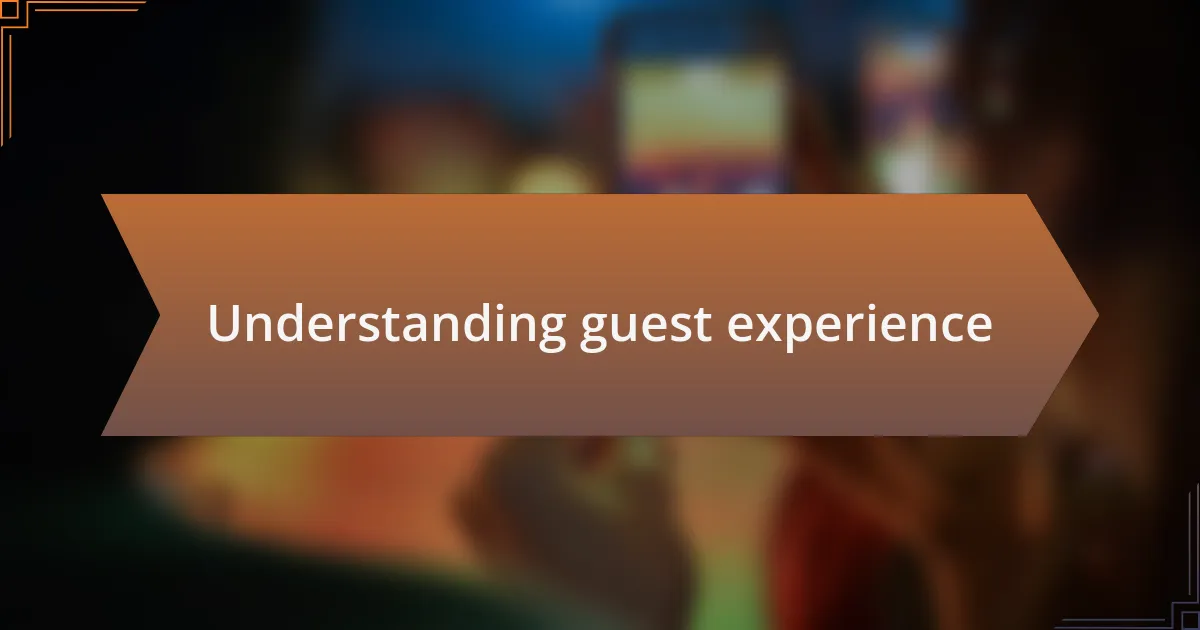
Understanding guest experience
When I think about guest experience, I’m often reminded of a corporate retreat I organized last year. One small touch, like personalized welcome notes, transformed the atmosphere and made guests feel valued from the moment they arrived. Isn’t it fascinating how such seemingly minor details can create lasting memories?
I once attended an event where the hosts failed to consider the flow of activities. It left guests confused and disengaged. This experience solidified my understanding of how crucial it is to think through every aspect of the journey from arrival to departure. Have you ever experienced that feeling of being lost in an event? It’s frustrating! Designing clear paths and intuitive layouts can make all the difference in keeping guests engaged.
I believe emotions play a significant role in shaping guest experience. For instance, during a wedding I helped plan, the couple designed an interactive photo booth that encouraged laughter and spontaneity. When I watched their friends and family genuinely enjoy themselves, it struck me how creating moments of connection can elevate an ordinary event into something truly memorable. What emotional connections are you fostering in your own events?
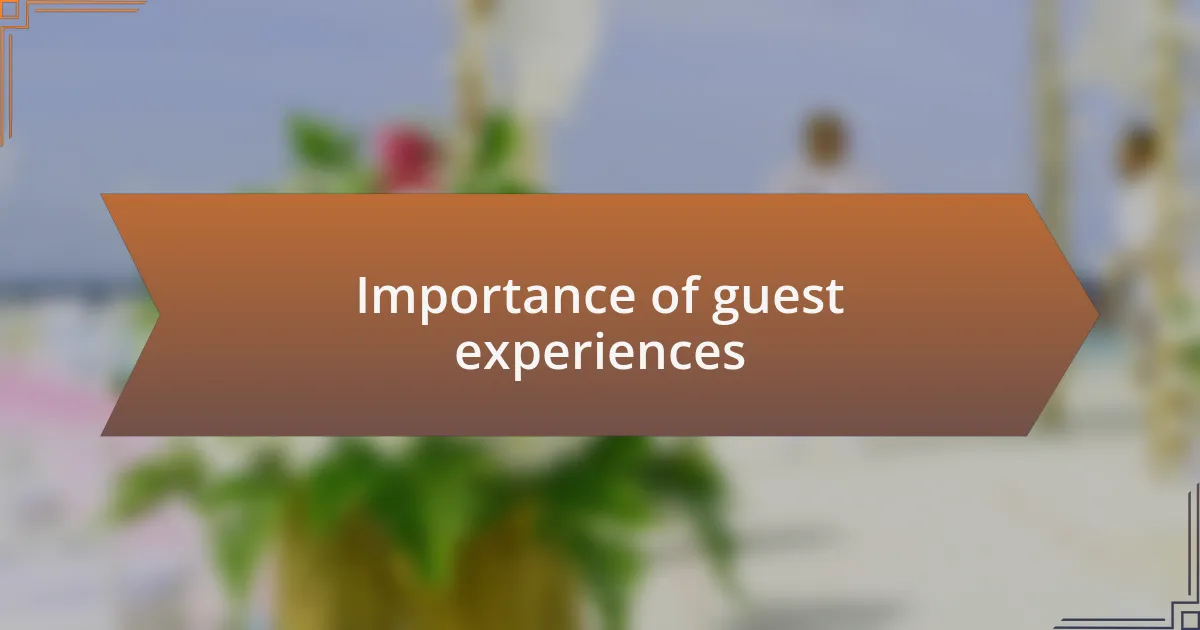
Importance of guest experiences
When we think about the importance of guest experiences, I remember a charity gala I once attended. The attention to detail in creating an uplifting atmosphere, like using warm lighting and engaging speakers, transformed a simple fundraising event into a powerful gathering. This made me realize that a well-crafted experience doesn’t just serve a function; it stirs emotions and builds connections that can inspire action.
In another instance, I planned a conference where we implemented interactive workshops tailored to the audience’s interests. The feedback was overwhelmingly positive; attendees appreciated being active participants rather than passive spectators. Isn’t it amazing how incorporating guest preferences can enhance engagement and loyalty? I’ve often found that when guests feel involved and valued, they are more likely to share their positive experiences, creating a ripple effect that can draw in new attendees for future events.
Let’s not forget the power of storytelling in guest experiences. At a tech expo I managed, we featured speakers who shared compelling personal journeys alongside their innovations. The energy in the room shifted as guests connected with the narratives; it was a reminder that experiences resonate more deeply when they incorporate authentic stories. Have you ever felt more engaged when someone shares their genuine journey? Those moments of connection are what make events unforgettable.
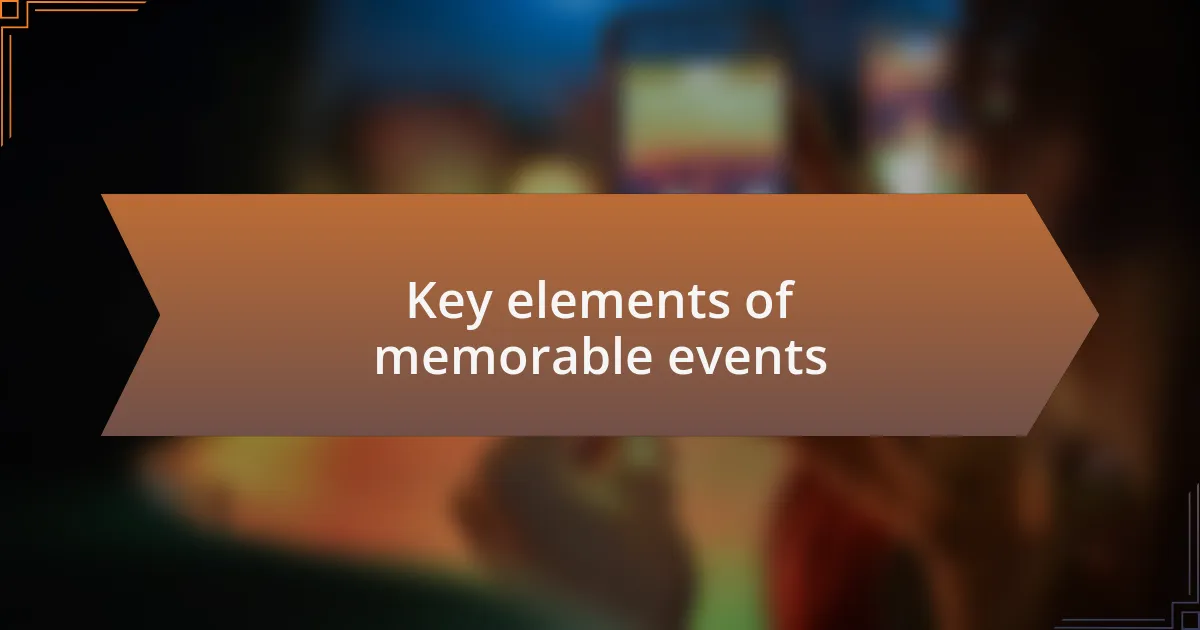
Key elements of memorable events
Creating memorable events hinges on several key elements that resonate with guests on a personal level. I recall organizing a birthday celebration where the theme was carefully tailored to reflect the guest of honor’s favorite hobbies. From custom decorations to a menu inspired by their culinary tastes, every detail was meticulously planned to create a personal connection. Isn’t it fascinating how these tailored touches can make the event feel special and unique?
Another crucial element is the ambiance. At a corporate retreat I facilitated, we opted for a serene outdoor setting that invited relaxation and openness. Participants responded positively to the natural surroundings, which led to more meaningful conversations and insights during workshops. Have you noticed that a change in environment can significantly alter the mood of an event? I believe this highlights the importance of not just what is done, but where it is done.
Lastly, engaging entertainment can elevate an event from ordinary to unforgettable. During a community festival I helped coordinate, we integrated live performances and interactive activities that encouraged participation. The laughter and joy shared among attendees created a vibrant atmosphere that was palpable. Isn’t it true that we often remember events not merely for what we did, but for the joy we felt? I’ve seen firsthand how dynamic entertainment fosters connections that linger long after the event concludes.
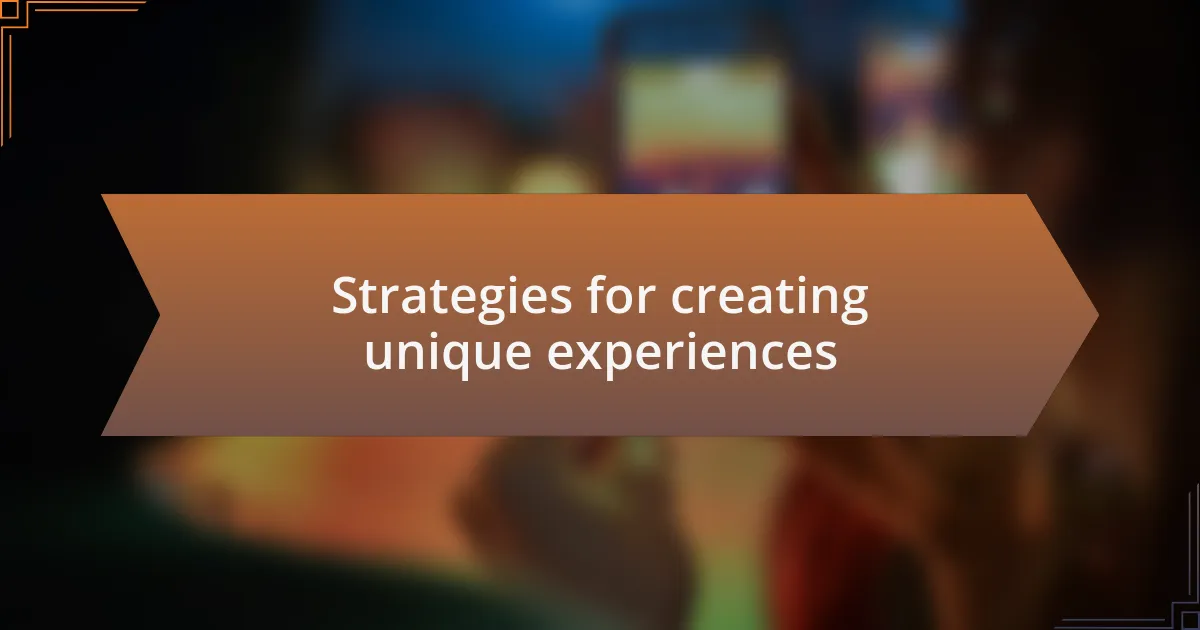
Strategies for creating unique experiences
Creating unique experiences often starts with personalization. I recall planning a small networking event where I sent out a pre-event survey to gauge guests’ interests and preferences. This not only shaped the program but also made attendees feel valued and connected before they even arrived. Isn’t it incredible how a little extra effort in understanding your guests can transform their perception of an event?
Another effective strategy is to incorporate sensory elements that captivate attendees. For instance, during a charity gala I organized, we used aromatic candles, mood lighting, and a carefully curated playlist. These details connected guests to the event on multiple sensory levels, heightening their overall experience. Have you ever noticed how certain scents or sounds can evoke powerful memories? I’ve found that appealing to different senses can create an immersive atmosphere that leaves a lasting impression.
Lastly, fostering interaction among guests can make all the difference. At a recent workshop I hosted, we utilized team-building exercises designed to encourage collaboration and spontaneity. The breakthroughs and laughter during those activities not only created bonds but also sparked creativity. Isn’t it magical to witness strangers become friends right before your eyes? In my experience, these shared moments transform an event from a passive experience into an engaging community celebration.
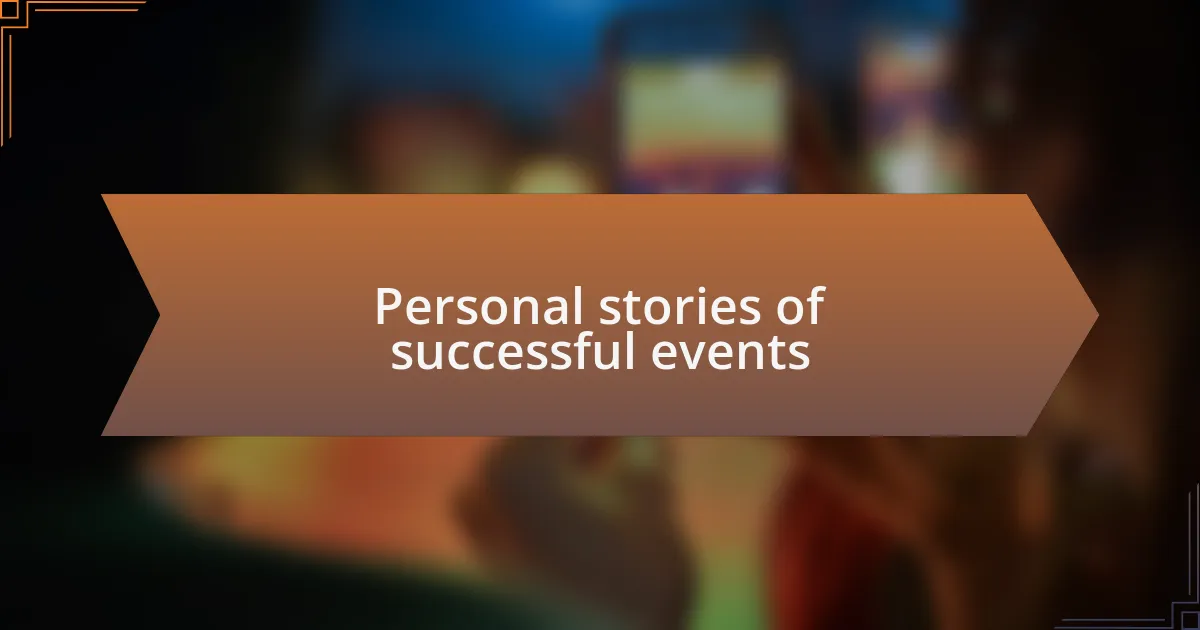
Personal stories of successful events
I remember a corporate retreat I organized that completely exceeded expectations. We integrated storytelling sessions where team members shared personal experiences related to their work journey. It was remarkable to see how vulnerability broke down barriers, fostering deeper connections that extended beyond the event. Have you ever felt a room shift with genuine camaraderie? It’s a powerful reminder of how shared stories can knit people together.
One event that stands out in my mind was a milestone birthday celebration for a client. I encouraged attendees to write down their favorite memories with the birthday person on small cards. Those heartfelt notes became part of a memory wall, resulting in a colorful tapestry of experiences that guests could revisit throughout the night. The emotions ran high when the guest of honor read those notes aloud. How can something as simple as a card spark such profound joy? It’s about creating something tangible that reflects their unique journey.
At a recent product launch, we took the interactive route by incorporating live polling and Q&A sessions. The immediate feedback created an electric atmosphere where attendees felt their voices mattered. It was thrilling to witness audience members suddenly take ownership of discussions, transforming the event from a presentation into an engaging dialogue. Have you ever been part of an experience where your opinions shaped the moment? It’s moments like these that breathe life into events and keep attendees buzzing long after they leave.
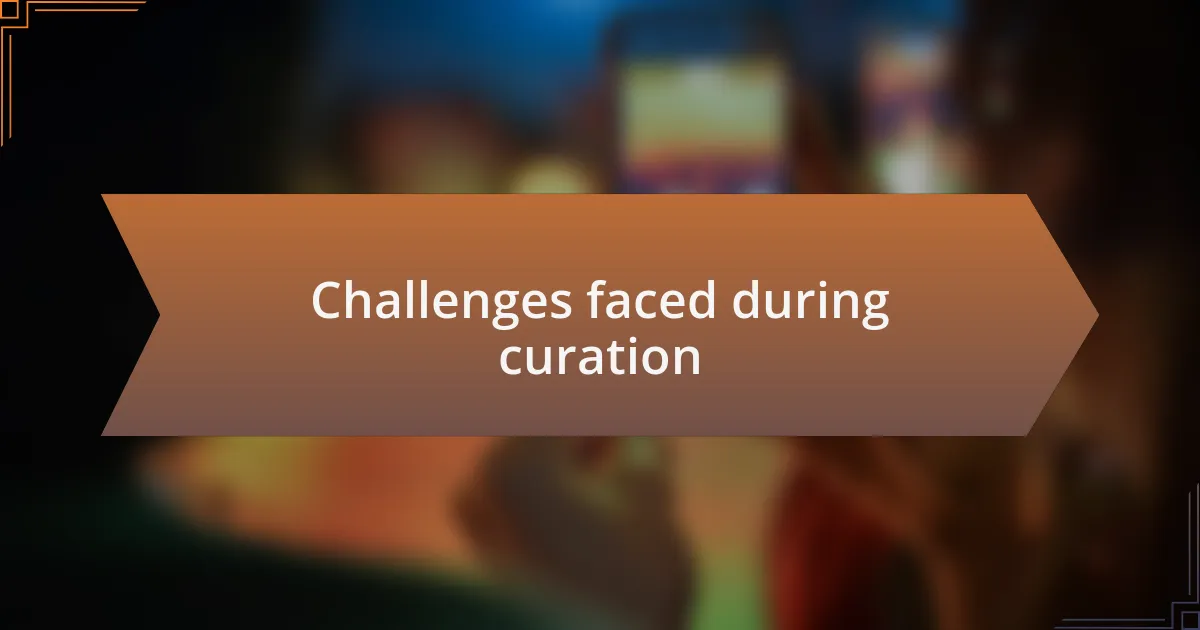
Challenges faced during curation
Identifying the right elements to curate memorable guest experiences is often fraught with unexpected hurdles. One challenge I encountered during a high-profile gala was accommodating diverse dietary restrictions. Imagine preparing an exquisite menu, only to find that several attendees couldn’t partake in any of the offerings. It taught me the importance of planning ahead and communicating with guests—proactive measures that can prevent potential disappointments.
Timing can also be a significant obstacle during the curation process. During a wedding I organized, we faced unforeseen delays that shifted the entire schedule. It’s a feeling of helplessness when the timeline you meticulously crafted starts to unravel. I learned that adaptability is crucial; sometimes you just have to pivot and create a new experience on the fly, which can lead to unexpected and delightful outcomes.
The emotional aspect of guest curation often adds layers of complexity that can’t be easily measured. For example, while planning a memorial service, I grappled with balancing sensitivity and celebration of life. It’s a delicate dance that requires intuition and empathy—how do you design an event that honors a life without overshadowing the grief? This taught me that the process is as much about emotional resonance as it is about logistics, reminding me to remain fully present and aware of the unique atmosphere each occasion brings.
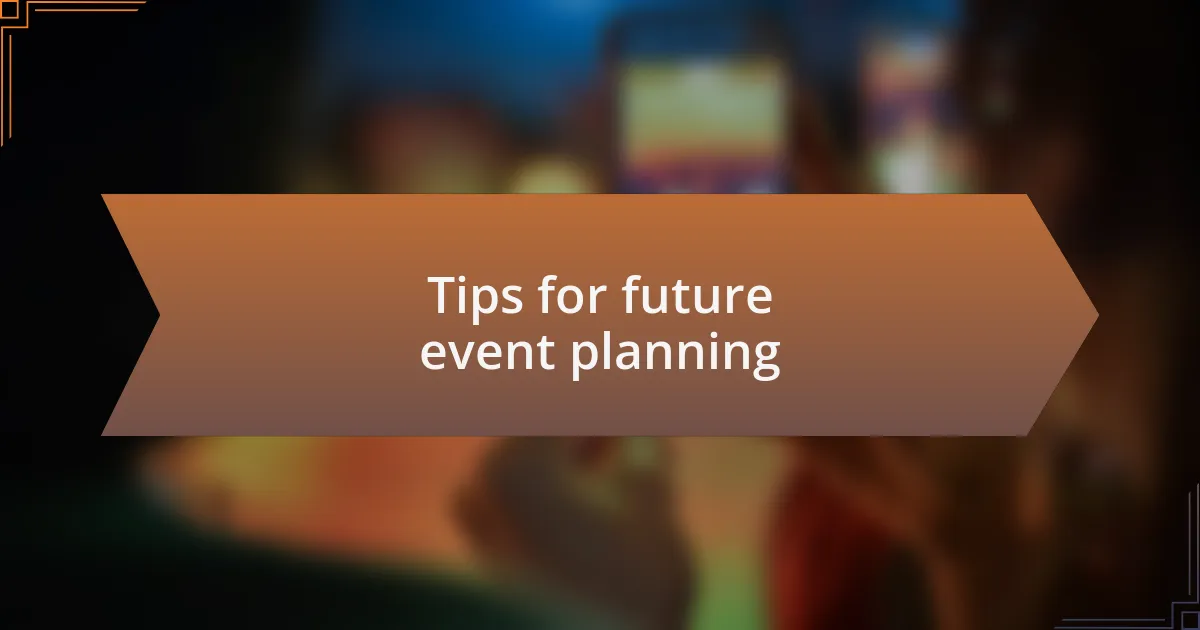
Tips for future event planning
When planning future events, I’ve realized the importance of creating a comprehensive checklist tailored to each occasion. I remember a networking event where I thought I had covered all bases, only to arrive and discover we lacked enough power outlets for everyone’s devices. This taught me to consider not just the basics but also the unique needs of attendees—what can make their experience seamless and enjoyable?
Budgeting is another aspect that can be tricky but is crucial for success. I once overspent on extravagant decorations for a birthday celebration and had to scramble at the last minute to pull together a suitable catering option. This experience highlighted for me the need for a balanced approach—allocating funds wisely can lead to a more satisfying overall event without breaking the bank. Have I ever made compromises in one area to prioritize another? Absolutely, and those choices often lead to the most memorable experiences.
Lastly, never underestimate the power of gathering feedback. After each event, I’ve made it a point to ask attendees what they liked and what could be improved. One time, a guest mentioned that interactive activities were a highlight, sparking an idea to incorporate more engagement in future gatherings. Listening to your audience not only shows that you value their opinions but also helps you craft events that resonate deeply with their desires. What better way to refine your skills than by understanding the experience from their perspective?